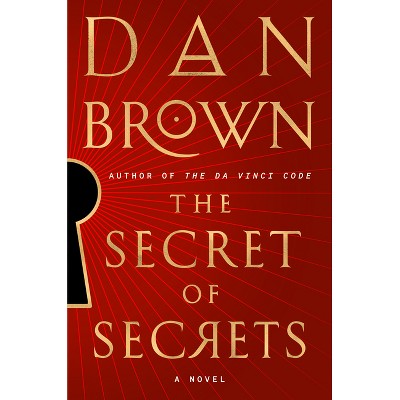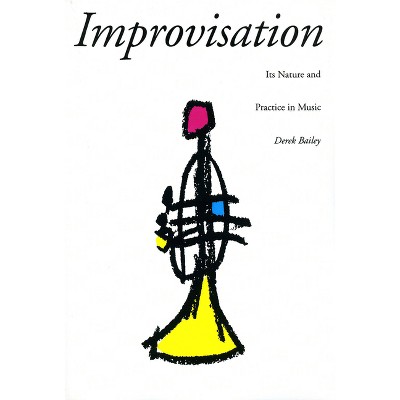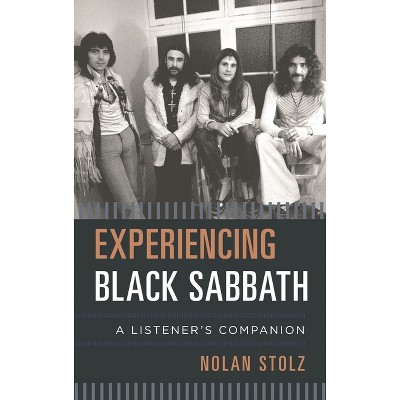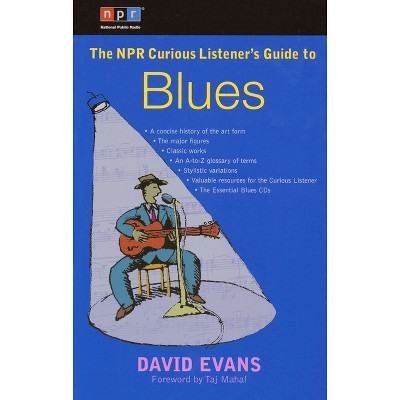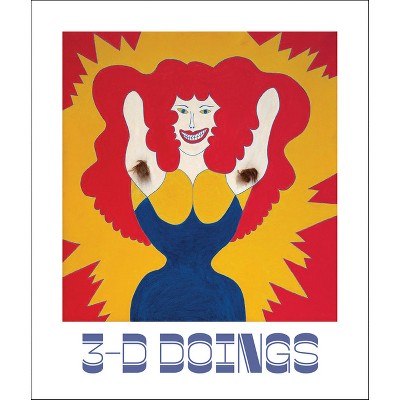Sponsored

A Listener's Guide to Free Improvisation - by John Corbett (Paperback)
$15.00
In Stock
Eligible for registries and wish lists
Sponsored
About this item
Highlights
- Improvisation rattles some listeners.
- About the Author: John Corbett is a writer, producer, and curator based in Chicago who has written extensively on jazz and improvised music.
- 112 Pages
- Music, Genres & Styles
Description
About the Book
John Corbett has written a tiny pocket guide to aid novices and devotees alike in listening to and understanding free, improvised music. The term improvised music can mean many things: but in this book the focus is on experimental music that does not have a structured song or tune, and that operates mainly in the vein of jazz or a jazz hybrid (blues, etc.). There are elegant discussions of music fundamentals (rhythm, duration, interaction dynamics, transitions, personal vocabulary), advanced techniques for listening and watching in live concerts, excellent analysis grounded in anecdote about the role of the audience, ambiguity, as well as historical anecdotes and thoughts on what it means to be a listener and what role music might have in our lives. The tone is light, with a serious undertone. "Book Synopsis
Improvisation rattles some listeners. Maybe they're even suspicious of it. John Coltrane's saxophonic flights of fancy, Jimi Hendrix's feedback drenched guitar solos, Ravi Shankar's sitar extrapolations--all these sounds seem like so much noodling or jamming, indulgent self-expression. "Just" improvising, as is sometimes said. For these music fans, it seems natural that music is meant to be composed. In the first book of its kind, John Corbett's A Listener's Guide to Free Improvisation provides a how-to manual for the most extreme example of spontaneous improvising: music with no pre-planned material at all. Drawing on over three decades of writing about, presenting, playing, teaching, and studying freely improvised music, Corbett offers an enriching set of tools that show any curious listener how to really listen, and he encourages them to enjoy the human impulse-- found all around the world-- to make up music on the spot. Corbett equips his reader for a journey into a difficult musical landscape, where there is no steady beat, no pre-ordained format, no overarching melodic or harmonic framework, and where tones can ring with the sharpest of burrs. In "Fundamentals," he explores key areas of interest, such as how the musicians interact, the malleability of time, overcoming impatience, and watching out for changes and transitions; he grounds these observations in concrete listening exercises, a veritable training regime for musical attentiveness. Then he takes readers deeper in "Advanced Techniques," plumbing the philosophical conundrums at the heart of free improvisation, including topics such as the influence of the audience and the counterintuitive challenge of listening while asleep. Scattered throughout are helpful and accessible lists of essential resources--recordings, books, videos-- and a registry of major practicing free improvisors from Noël Akchoté to John Zorn, particularly essential because this music is best experienced live. The result is a concise, humorous, and inspiring guide, a unique book that will help transform one of the world's most notoriously unapproachable artforms into a rewarding and enjoyable experience.Review Quotes
"A Listener's Guide to Free Improvisation expertly navigates music that can seem thoroughly foreign and intimidating. Yet Corbett handles the material with grace and humor, intelligence and curiosity, in prose that unlike some writing on the subject, is easy to read and accessible to everyone. . . . a strangely soothing read, finding beauty and order amidst seeming chaos like a Zen master who describes a blade of grass bending but not breaking in the wind."
-- "Spectrum Culture"
"A much-needed book for the open-minded listener--a well-written volume from jazz critic John Corbett--and one that's bound to widen your ears to a whole new realm of listening! The book's pocket-sized--maybe so that you can sneak it into a club when visiting a free jazz concert--and it's written in a style that's both personal, but very directive--with a full understanding of the complexities that come into play when listening to improvised music, and a guide towards facing some of the more difficult challenges involved! Corbett clearly loves this music, but without any sort of high ideals--none of the too-cool-for-school modes that are usually standard with the avant garde, and instead this very down to earth approach that shows the listener that they've got all the tools needed to enjoy the music themselves. The goal here (one we can totally endorse) is to bring the listener face to face with new and challenging sounds--but in a way that allows them to instantly contextualize them too--yet without having to carry years of jazz or musical experience into the process. The book is divided up into easy-to-digest sections--and penned with a surprisingly warm style too."
-- "Dusty Groove"
"A refreshingly pragmatic book. . . . As a primer, it's a valuable guide and even seasoned listeners will find it useful to be reminded what distinguishes free improvisation from other music and the kinds of things to which they should be alive."
-- "Free Jazz Collective"
"Corbett has been listening to free improvisation for years and beyond that, has organized shows, curated festivals, and even engineered recording sessions for the music. Now, with A Listener's Guide to Free Improvisation, he has attempted to build a bridge to potential listeners by writing a kind of guide for the perplexed on how to listen to music that doesn't follow the conventions of ordinary song. . . . The advice he offers is practical and illuminating."--Perfect Sound Forever
-- "Perfect Sound Forever"
"It took me years and lots of listening to understand free improvisation, and in the beginning Corbett was a big help for me. This handy book breaks down the basics of free improvisation, a theoretically non-idiomatic practice where musicians get together with nothing planned and simply make music spontaneously, focusing on interaction and largely dispensing with the qualities we expect in music--fixed structure, melody, regular rhythms, standard harmony. Free improvisation is about sound and interplay, though that doesn't quite sum it up. Corbett mostly does without name dropping and jargon--he designed his book for the novice, and he takes pains to keep things clear and approachable, even if what he's writing about is anything but accessible to most listeners."
-- "Chicago Reader"
"It's hard enough to put music into words but even harder when it's created without preconceived plans. Kudos, then, to John Corbett for his insight into how one can gain deeper understandings of and appreciation for such music. Written in a pithy, metaphor-steeped style, Corbett's book is humorous and engaging; he's having a bit of fun with a subject about which he cares deeply. Fond of enlarging on his metaphors, as when he shows the various ways the book is like a field guide for birdwatching, he's equally content to string a series of mixed metaphors together, thereby acknowledging the imprecise nature of such allusions, all merely parts, hints, of the bigger 'truth' he wants to illuminate."
-- "New York City Jazz Record"
"Lays down a golden road to understanding free improvisation. . . . A Listener's Guide is, essentially, and in the best way possible, a popular how-to manual from a master who has spent years in the field. Reading Corbett is like spending an afternoon with your favorite uncle and his cabinet of booze. By the end, you won't necessarily know the names of the different bourbons, but you'll know what tastes good."
-- "MAKE"
"The perfect example of what any field guide to music (or any other art form) should be. Small enough to fit in a pocket at barely over 4″ x 6″, the book is a practical guide for those new to free improvisation, though there is plenty of information for an experienced listener to pick up something new. . . . This book will undoubtedly be useful to anyone who is interested in improvised music or even music in general. These listening techniques could easily be applied to most forms of music. It would be nice to see this book be adopted as a text for music appreciation and history classes. I wish this book had been around when I started listening to and performing free improvisation. This is an essential text for the next generations of listeners."-- "Burning Ambulance"
"It's hard enough to put music into words, but even harder when it's created without preconceived plans. Kudos then to John Corbett for his insight into how one can gain deeper understanding of and appreciation for such music."--Tom Greenland "New York City Jazz Record"
About the Author
John Corbett is a writer, producer, and curator based in Chicago who has written extensively on jazz and improvised music. A regular contributor to DownBeat magazine, he is the author of several books, including Extended Play: Sounding Off from John Cage to Dr. Funkenstein and Microgroove: Forays Into Other Music.Dimensions (Overall): 6.2 Inches (H) x 4.2 Inches (W) x .5 Inches (D)
Weight: .35 Pounds
Suggested Age: 22 Years and Up
Number of Pages: 112
Genre: Music
Sub-Genre: Genres & Styles
Publisher: University of Chicago Press
Theme: Jazz
Format: Paperback
Author: John Corbett
Language: English
Street Date: March 13, 2016
TCIN: 1006093622
UPC: 9780226353807
Item Number (DPCI): 247-34-6640
Origin: Made in the USA or Imported
If the item details aren’t accurate or complete, we want to know about it.
Shipping details
Estimated ship dimensions: 0.5 inches length x 4.2 inches width x 6.2 inches height
Estimated ship weight: 0.35 pounds
We regret that this item cannot be shipped to PO Boxes.
This item cannot be shipped to the following locations: American Samoa (see also separate entry under AS), Guam (see also separate entry under GU), Northern Mariana Islands, Puerto Rico (see also separate entry under PR), United States Minor Outlying Islands, Virgin Islands, U.S., APO/FPO
Return details
This item can be returned to any Target store or Target.com.
This item must be returned within 90 days of the date it was purchased in store, shipped, delivered by a Shipt shopper, or made ready for pickup.
See the return policy for complete information.
Trending Poetry


$9.85 - $23.09
MSRP $15.99 - $32.99
4.8 out of 5 stars with 144 ratings

